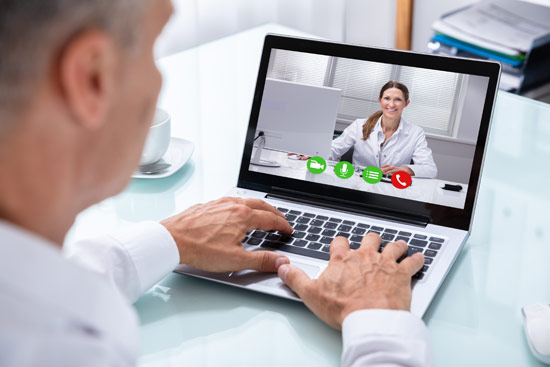
Before the current emergency, doctors had been slow to adopt telemedicine for a variety of reasons, with most obstacles being outside of their control. Policy, infrastructure/technology, lack of reimbursements, and cost have been the primary barriers for healthcare providers.
If there will be a silver lining to the current health crisis, it may be the end of some barriers to telehealth. Telemedicine and telepsychiatry are particularly important now, as the nation faces a potential dual crisis of increased cases of depression and a shortage of mental healthcare professionals to help manage them.
What is the Difference Between Telemedicine, Telehealth and Telepsychiatry?
Although the terms “telemedicine” and “telehealth” are often used interchangeably, according to the American Academy of Family Physicians, “while telemedicine refers specifically to remote clinical services, telehealth can refer to remote non-clinical services such as provider training, continuing medical education or public health education, administrative meetings, and electronic information sharing to facilitate and support assessment, diagnosis, consultation, treatment, education, and care management.”
Telemedicine incorporates a variety of technologies. Most common are real-time, HIPAA-compliant communication tools provided by third-party providers that connect physicians and patients in different locations via video and audio.
The American Psychiatric Association (APA) says that telepsychiatry “can involve providing a range of services including psychiatric evaluations, therapy (individual therapy, group therapy, family therapy), patient education and medication management.”
Further, the APA shared the effectiveness of telepsychiatry, writing:
“There is substantial evidence of the effectiveness of telepsychiatry and research has found satisfaction to be high among patients, psychiatrists and other professionals. Telepsychiatry is equivalent to in-person care in diagnostic accuracy, treatment effectiveness, quality of care and patient satisfaction. Patient privacy and confidentialityare equivalent to in-person care.”
The APA has put together a comprehensive Telepsychiatry Toolkit for psychiatrists that shares details on requirements and considerations. The Telepsychiatry Toolkit is an “evolving resource for members who want to learn about the various aspects of telepsychiatry, including clinical, training, and policy considerations.”
Developed by the APA Work Group on Telepsychiatry, the toolkit includes modules on history, training, technical considerations, practice/clinical, reimbursement and legal issues from leading psychiatrists. More resources and information are expected to be added as new topics emerge.
Relaxation of Telehealth Regulations

A primary obstacle in telemedicine is insurance coverage, which has been limited. In a major break for providers, the Centers for Medicaid and Medicare Services (CMS) has temporarily expanded Medicare coverage for telehealth, which includes many “many behavioral health and patient education services.”
Geography has also been a regulatory issue for healthcare providers. To overcome this obstacle, CMS has temporarily waived the requirement that a physician must be licensed in the state where the patient is located at the time of treatment, although state requirements will still apply. Accordingly, Medicare patients and states may request a waiver for Medicaid patients for treatment.
HHS’s Office for Civil Rights (OCR) responsible for HIPAA compliance has issued a notification that it will use “enforcement discretion” for the “good faith provision of telehealth services.” This includes the use and development of some mental health apps that allow for communication. The APA has created a tool to help doctors evaluate the effectiveness and safety of mental health apps, and includes criteria that can help you choose a particular app.
“We are empowering medical providers to serve patients wherever they are during this national public health emergency,” writes OCR Director Roger Severino in the notification. “We are especially concerned about reaching those most at risk, including older persons and persons with disabilities.”
The OCR has allowed a number of popular video chat apps to provide telehealth, including:
- Apple FaceTime
- Facebook Messenger video chat
- Google Hangouts video
- Zoom
- Skype
These are typically not approved for use in telemedicine because of privacy and security issues. The agency suggests that providers should “notify patients that these third-party applications potentially introduce privacy risks, and providers should enable all available encryption and privacy modes when using such applications.”
“There is No Better Time” to Set Up a Telemedicine Practice

- Set up a team that can make telemedicine services implementation decisions quickly
- Check with your malpractice insurance carrier to verify your policy covers care provided via telemedicine
- Familiarize yourself with payment and policy guidelines specific to various telemedicine services
“…there is no better time to help physicians navigate and implement telemedicine into their practices and enhance their ability to care for patients,” writes Dr. Russell Libby, pediatrician & board member, Physicians Foundation, in the introduction to the AMA Telehealth Implementation Playbook. “The tools and guidelines being created now are already helping many to use telemedicine and will continue to help define its role at this moment and shape the future of physician practice.”
During this national health emergency, we created GeneSight® at Home, an optional feature meant to provide support for clinics, providers, and staff that have transitioned to remote delivery models. Read instructions on how to ship the GeneSight® test kit directly to remote patients.
Our articles are for informational purposes only and are reviewed by our Medical Information team, which includes PharmDs, MDs, and PhDs. Do not make any changes to your current medications or dosing without consulting your healthcare provider.
The GeneSight test must be ordered by and used only in consultation with a healthcare provider who can prescribe medications. As with all genetic tests, the GeneSight test results have limitations and do not constitute medical advice. The test results are designed to be just one part of a larger, complete patient assessment, which would include proper diagnosis and consideration of your medical history, other medications you may be taking, your family history, and other factors.
If you are a healthcare provider and interested in learning more about the GeneSight test, please contact us at 855.891.9415. If you are a patient, please talk with your doctor to see if the GeneSight test may be helpful.




